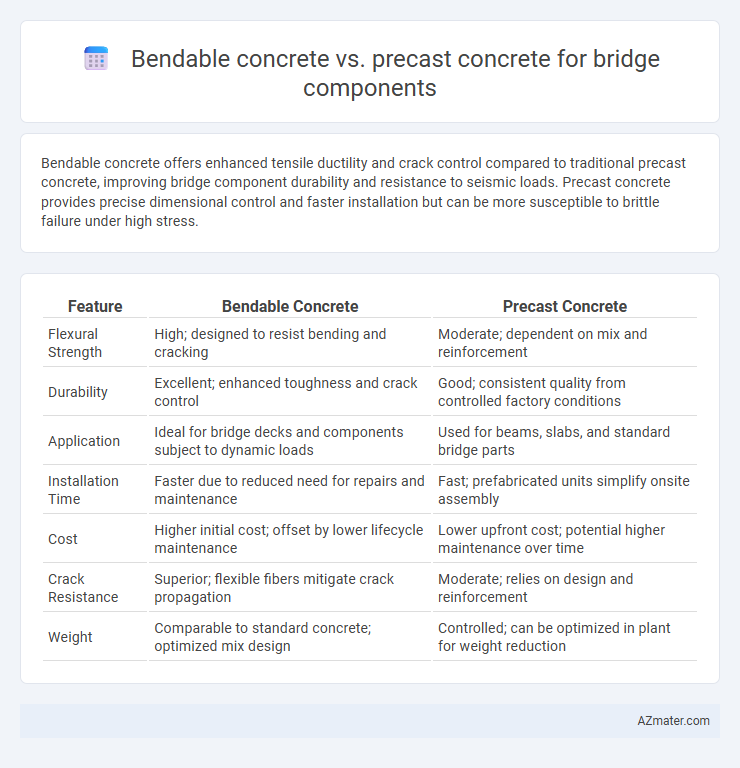Bendable concrete offers enhanced tensile ductility and crack control compared to traditional precast concrete, improving bridge component durability and resistance to seismic loads. Precast concrete provides precise dimensional control and faster installation but can be more susceptible to brittle failure under high stress.
Table of Comparison
| Feature | Bendable Concrete | Precast Concrete |
|---|---|---|
| Flexural Strength | High; designed to resist bending and cracking | Moderate; dependent on mix and reinforcement |
| Durability | Excellent; enhanced toughness and crack control | Good; consistent quality from controlled factory conditions |
| Application | Ideal for bridge decks and components subject to dynamic loads | Used for beams, slabs, and standard bridge parts |
| Installation Time | Faster due to reduced need for repairs and maintenance | Fast; prefabricated units simplify onsite assembly |
| Cost | Higher initial cost; offset by lower lifecycle maintenance | Lower upfront cost; potential higher maintenance over time |
| Crack Resistance | Superior; flexible fibers mitigate crack propagation | Moderate; relies on design and reinforcement |
| Weight | Comparable to standard concrete; optimized mix design | Controlled; can be optimized in plant for weight reduction |
Introduction to Innovative Bridge Materials
Bendable concrete, characterized by high tensile ductility and fiber reinforcement, offers enhanced crack resistance and improved durability compared to traditional precast concrete components used in bridges. Precast concrete, widely utilized due to its controlled manufacturing environment and ease of installation, provides strength and uniformity but can be prone to brittle failure under extreme loads. Innovations in bendable concrete materials are transforming bridge engineering by combining flexibility with structural integrity, ultimately extending service life and reducing maintenance costs.
Overview of Bendable Concrete Technology
Bendable concrete technology incorporates engineered fibers and extensive crack control mechanisms to enhance flexibility and tensile strength, making it ideal for bridge components subjected to dynamic loads and environmental stresses. Unlike traditional precast concrete, which relies on rigid molds and standard reinforcement, bendable concrete reduces the risk of brittle failure and improves durability by allowing controlled micro-cracking without significant loss of structural integrity. This innovation extends the lifespan of bridge elements, lowers maintenance costs, and supports sustainable infrastructure development through increased resilience and material efficiency.
Understanding Precast Concrete in Bridge Construction
Precast concrete offers precise quality control and accelerated installation for bridge components, enhancing durability and load-bearing capacity. Its factory-cast elements enable consistent strength and reduce on-site labor time compared to bendable concrete, which emphasizes flexibility but may lack comparable structural uniformity. The use of precast concrete facilitates modular bridge construction, improving project timelines and minimizing traffic disruptions during installation.
Key Material Properties: Flexibility vs. Rigidity
Bendable concrete offers enhanced flexibility and tensile strain capacity, allowing bridge components to withstand dynamic loads and resist cracking under deformation. Precast concrete is characterized by high rigidity and compressive strength, providing excellent dimensional stability and load-bearing capacity in bridge structures. The choice between these materials depends on the need for deformation tolerance versus structural stiffness in bridge design.
Installation Process Comparison
Bendable concrete offers enhanced flexibility during installation as it can accommodate slight deformations without cracking, reducing the need for precise alignment and minimizing installation errors on bridge components. Precast concrete requires meticulous placement and alignment due to its rigid properties, often necessitating heavy lifting equipment and extended set-up times to ensure structural integrity. The installation speed of bendable concrete is generally faster, lowering labor costs and improving efficiency in bridge construction projects.
Structural Performance and Durability
Bendable concrete exhibits superior structural performance in bridge components due to its high tensile strain capacity and enhanced crack control, which significantly reduces maintenance costs and extends service life. Precast concrete offers consistent quality and rapid installation but may be prone to joint weaknesses and limited ductility under dynamic loads. The durability of bendable concrete outperforms precast concrete by mitigating crack propagation and corrosion of reinforcement, ensuring long-term structural integrity in aggressive environmental conditions.
Cost Analysis and Lifecycle Considerations
Bendable concrete exhibits enhanced crack resistance and reduced maintenance costs compared to precast concrete, offering a longer lifecycle for bridge components despite a higher initial investment. Precast concrete provides lower upfront costs and faster installation times, but may incur greater long-term expenses due to potential cracking and repair needs. Evaluating total cost of ownership favors bendable concrete in durability-driven projects where lifecycle savings outweigh initial expenditures.
Maintenance and Repair Requirements
Bendable concrete offers enhanced crack control and flexibility, significantly reducing maintenance frequency and repair costs for bridge components compared to precast concrete. Precast concrete, while durable and quick to install, often experiences higher susceptibility to cracking under dynamic loads, necessitating more frequent inspections and repairs. The self-healing properties of bendable concrete contribute to increased longevity and resilience, lowering long-term maintenance efforts in bridge infrastructure.
Environmental and Sustainability Impacts
Bendable concrete significantly reduces environmental impact by enhancing durability and minimizing cracking, thereby decreasing the frequency of repairs and material replacement needed for bridge components. Precast concrete, while offering controlled manufacturing conditions that can reduce waste and energy use, may have higher embodied carbon due to transportation and formwork requirements. Choosing bendable concrete supports sustainability goals by lowering lifecycle emissions and extending the service life of bridge structures through improved toughness and resilience.
Applications and Case Studies in Bridge Components
Bendable concrete offers superior flexural performance and crack control, making it ideal for bridge components subjected to dynamic loads and seismic activity, as demonstrated in California's Smart Bridge project. Precast concrete is widely used for rapid construction and durability in repetitive elements like bridge decks and girders, exemplified by the I-495 Express Lanes in Virginia. Case studies reveal that bendable concrete enhances structural resilience in complex shapes, while precast concrete excels in standardization and accelerated project timelines.

Infographic: Bendable concrete vs Precast concrete for Bridge component
 azmater.com
azmater.com